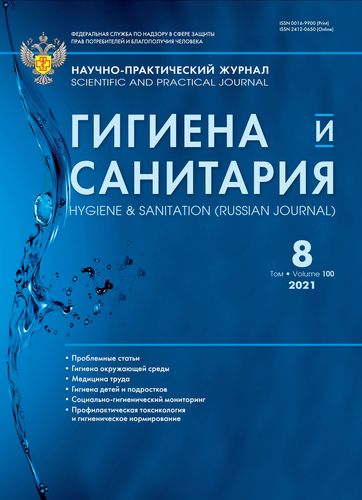Вопросы отечественного и международного нормирования лазерной безопасности для населения (обзор литературы)
- Авторы: Малькова Н.Ю.1,2, Петрова М.Д.1
-
Учреждения:
- ФБУН «Северо-Западный научный центр гигиены и общественного здоровья» Федеральной службы по надзору в сфере защиты прав потребителей и благополучия человека
- ФГБОУ ВО «Северо-Западный государственный медицинский университет имени И.И. Мечникова» Министерства здравоохранения Российской Федерации
- Выпуск: Том 100, № 8 (2021)
- Страницы: 787-791
- Раздел: ГИГИЕНА ОКРУЖАЮЩЕЙ СРЕДЫ
- Статья опубликована: 31.08.2021
- URL: https://vestnik.nvsu.ru/0016-9900/article/view/639050
- DOI: https://doi.org/10.47470/0016-9900-2021-100-8-787-791
- ID: 639050
Цитировать
Полный текст
Аннотация
Введение. В статье представлен анализ существующей на сегодняшний день российской и иностранной литературы по вопросу отечественного и международного нормирования лазерной безопасности для населения.
Цель исследования – поиск информации и анализ отечественного и международного опыта в области нормирования уровней лазерного излучения для населения.
Проведён обзор доступных научных российских и иностранных литературных источников и нормативных документов. Поиск и отбор источников был осуществлён с использованием открытых баз данных PubMed и РИНЦ. Отечественные гигиенические нормативы лазерного излучения для непрерывного лазерного излучения в спектральном диапазоне 380–1400 нм являются на порядок более жёсткими, чем нормативы, применяемые за рубежом. В то же время при разработке ПДУ не учитывалась возможность действия излучения на население и слепящий эффект. Зарубежные и отечественные авторы отмечают особенности действия лазерного излучения видимой области спектра, в том числе его способность беспрепятственно проходить через оптические среды глаза и повреждать сетчатку и прилегающие ткани. Анализ нормативных документов показал ряд различий в нормировании российских и международных стандартов, а также несовпадение и размытость требований в существующих санитарно-эпидемиологических документах.
Заключение. Существующие стандарты порой противоречат друг другу, что мешает грамотной оценке опасности лазера и лазерной системы, поэтому пересмотр существующей нормативной базы лазерной безопасности для населения является актуальной задачей, решение которой позволит минимизировать негативные изменения со стороны органа зрения у лиц, не связанных профессионально с действием лазерного излучения, и качественно улучшить гигиеническую оценку лазерного излучения.
Участие авторов:
Малькова Н.Ю. — концепция и дизайн исследования, анализ и интерпретация данных, утверждение окончательного варианта статьи, ответственность за целостность всех частей статьи;
Петрова М.Д. — сбор и анализ данных, написание текста, редактирование.
Конфликт интересов. Авторы декларируют отсутствие явных и потенциальных конфликтов интересов в связи с публикацией данной статьи.
Финансирование. Исследование не имело спонсорской поддержки.
Ключевые слова
Об авторах
Наталия Юрьевна Малькова
ФБУН «Северо-Западный научный центр гигиены и общественного здоровья» Федеральной службы по надзору в сфере защиты прав потребителей и благополучия человека; ФГБОУ ВО «Северо-Западный государственный медицинский университет имени И.И. Мечникова» Министерства здравоохранения Российской Федерации
Автор, ответственный за переписку.
Email: lasergrmal@mail.ru
ORCID iD: 0000-0002-0426-8851
Доктор биол. наук, гл. науч. сотр. отд. комплексной гигиенической оценки физических факторов ФБУН
«Северо-Западный центр гигиены и общественного здоровья», 191036, Санкт-Петербург.
e-mail: lasergrmal@mail.ru
РоссияМ. Д. Петрова
ФБУН «Северо-Западный научный центр гигиены и общественного здоровья» Федеральной службы по надзору в сфере защиты прав потребителей и благополучия человека
Email: noemail@neicon.ru
ORCID iD: 0000-0001-5506-6523
Россия
Список литературы
- Левина Э.Ю. Компьютерный синтез изображения трехмерного объекта для лазерного дизайна в стекле. В кн.: Сборник докладов четырнадцатой научно-технической конференции «Фотометрия и её метрологическое обеспечение». М.; 2004: 122-4.
- Шикин E.B., Боресков A.B. Компьютерная графика. Динамика, реалистические изображения. М.: Диалог-МИФИ; 1996.
- Тучин В.В. Лазеры и волоконная оптика в биомедицинских исследованиях. М.: ФИЗМАТЛИТ; 2010.
- Доувер Дж.С., ред. Лазеро- и светолечение. М.: Рид Элсивер; 2010: 5-7.
- Kaminer M.S., Arndt K.A., Dover J.S., Rohrer T.E., Zachary C.B. Atlas of Cosmetic Surgery. Saunders-Elsevier; 2009.
- Jacques S.L. Role of tissue optics and pulse duration during high-power laser irradiation. Appl. Opt. 1993; 32(13): 2447-54. https://doi.org/10.1364/ao.32.002447
- Shah D., Desai N., Dhanak R. Lasers in facial aesthetics - a review. Adv. Hum. Biol. 2014; 4(3): 1-6.
- Желтов Г.И. Нормативы по лазерной безопасности: истоки, уровень, перспективы. Фотоника. 2017; (1): 10-35.
- Куликов А.Н., Власенко А.Н., Мальцев Д.С., Коваленко А.В., Коваленко И.Ю. Клинические случаи повреждения глаз излучением лазерных указок. Вестник Российской Военно-медицинской академии. 2019; 3(67): 103-6.
- Бойко Э.В., Шишкин М.М., Березин Ю.Д. Диодный лазер в офтальмологической операционной. СПб.; 2000.
- Черепнин А.И. Клинические случаи повреждения сетчатки в быту инфракрасным излучением лазерной указки. Современные технологии в офтальмологии. 2018; (2): 280-2.
- Девятков Н.Д., Зубова С.М., Лапрун И.В., Макеева Н.С. Физико-химические механизмы биологического действия лазерного излучения. Успехи современной Биологии. 1987; 103(1): 31-43.
- Горбатенкова Е.А., Владимиров Ю.А., Парамонов Н.В., Азизова О.А. Красный свет гелий-неонового лазера реактивирует супероксиддисмутазу. Бюллетень экспертной биологии и медицины. 1989; (107): 302-5.
- Соколовский В.В., Ушкова И.Н., Березин Ю.Д., Покровская Л.А., Родионова Л.П., Гончарова Л.Л. и соавт. О стимулирующем эффекте действия излучения гелий-неонового лазера на глаза кролика. Офтальмологический журнал. 1990; (3): 176-8.
- Ушкова И.Н., Березин Ю.Д., Покровская Л.А. О стимулирующем эффекте действия излучения лазера длиной волны 0,53 мкм на глаза кроликов. Офтальмологический журнал. 1991; (6): 351-2.
- Ушкова И.Н., Гончарова Л.Л., Покровская Л.А., Малькова Н.Ю., Муратов Е.В. Реакция организма на действие лазерного излучения длиной волны 0,44 мкм. Врачебное дело. 1992; (9): 71-3.
- Рахманов Б.Н., Пальцев Ю.П., Кибовский В.Т. Проблема противоречий в нормативной базе лазерной безопасности. Гигиена и санитария. 2017; 96(6): 535-40. https://doi.org/10.18821/0016-9900-2017-96-6-535-540
- Бибик О.Б., Садовников И.Э. К вопросу о нормативной базе по лазерной безопасности. Фотоника. 2017; (1): 38-41. https://doi.org/10.22184/1993-7296.2017.61.1.38.41
- Рахманов Б.Н., Кибовский В.Т. Лазерная безопасность. Документы новые - проблемы старые. Лазер-Информ. 2016; (21-22): 1-13.
- Малькова Н.Ю., Лугиня В.С. Проблемы технического регулирования в области фотоники. Фотоника. 2019; 13(2): 208-13.
Дополнительные файлы









